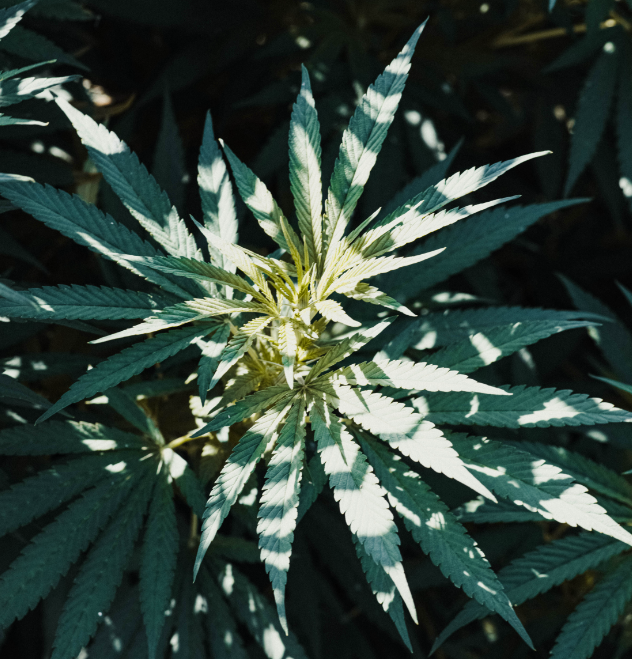In order to produce good and high-quality CBD oil, you need a few things: A good and reliable supplier of raw materials, a technically sophisticated laboratory, people with the necessary know-how and much more. At BergBlüten, we produce our CBD oil ourselves - from A to Z. That means: We are our own raw material supplier, have a technically sophisticated laboratory and employees with the necessary know-how. We grow our own plants and then process them into high-quality CBD oil using our proprietary process. In this blog we take you on the journey of a small CBD flower that sprout from the ground under the Glarner sun and finally comes to your home in a small bottle.
The raw material
breed
To make effective CBD oil , you need the right raw material to start with. Thanks to the collaboration with Scott Blakey aka Shanti Baba , a legend of the cannabis industry, we can draw on a large gene pool. Scott was one of the first to start breeding different cannabis strains over 35 years ago. Today we have the exclusive right to produce Scott Blakey's strains in Europe.

rearing
We propagate our mother plants with care every year. The mother plants ensure our gene pool so that we can always breed plants with the same characteristics. The mother plants are kept in the vegetative stage to produce healthy and genetically stable cuttings. Whole, densely planted fields of cannabis grow from a few mother plants. But before the cuttings find their way onto the field, they harden in the curing station to prepare them for the sometimes mild, sometimes stormy Swiss weather. Even if nature can throw a spanner in the works for us with hail or other extreme weather phenomena: we get the power of our plants from nature. The connection with nature is invaluable to us. Growing our CBD plants in the wild allows them to thrive in their natural habitat. They absorb nutrients from the soil, enjoy natural sunlight and benefit from fresh air currents.

dry
After the small seedlings have grown into large and floriferous plants, it is time to carefully dry the plants. Drying the crop should not be underestimated as mold grows very well in damp and dark places and must be avoided. Otherwise it is possible that we lose large parts of our harvest. We also attach great importance to drying our plants gently and for a long time. How come? So that chlorophyll (bitter chaff) evaporates in the air as much as possible. This improves the quality of the flowers for extraction. We're taking the extra time here so we can find a smaller percentage of chlorophyll in the buds. Less chlorophyll also means less bitter substances in the plant. This increases the quality of the end product even further.
sort by
After the flowers have dried, they are sorted. We only extract the flowers for products for the Swiss market, for example. Our plants are processed by hand. After cleaning and separating the flowers from leaves and stems, the flowers are bewitched into so-called trim. The leaves and stems are processed in two different ways: Part is put back into the soil to return nutrients. A part is used for the production of textiles, for example our very popular bed linen .
The production

The "3-mountain method"
Once the raw material is dried and in good condition, we can get to work and process the CBD flowers into CBD oil. As a company in the field of CBD products, we have developed our own, particularly gentle extraction process in cooperation with renowned partners such as the HES-SO Valais University of Applied Sciences. We call it the " 3 Mountain Process ". Based on this, we safely produce an active full-spectrum CBD extract.
The first peak of the 3-mountain process - the extraction
At the beginning of the 3-mountain procedure, the trim is briefly placed in ethanol. We then break up the trim quickly and thoroughly using ultrasound so that all of the cannabinoids are available to extract the CBD. We developed the method for CBD production of a full-spectrum extract together with Professors Piantini and Grogg at the Valais University of Applied Sciences (HES-SO) at the Life Technologies Institute based in Sion.
The second peak of the 3-mountain process - the concentration
Now the previously clarified ethanol mixture is concentrated to an extract by evaporation. It depends on the exact regulation of time and temperature. We heat the ethanol mixture just enough so that the liquid evaporates, but all the ingredients in the extract are retained.
The third peak of the 3-mountain-procedure - the activation
What many readers do not know or ignore: After concentration, the CBD is still in an inactive form. So it must now be activated during CBD production. In this step of the 3-mountain process, we heat the extract just enough to turn the cannabinoids into active cannabinoids. Activated and non-activated extract is then mixed to cover the full spectrum of CBD.

terpene profile
In accordance with our claim, we always want to improve our CBD oils and take them to the next level. The safety and effectiveness of our products is extremely important to us. Therefore, we regularly analyze our terpene profiles to make possible adjustments and offer the best possible quality.
Conclusion
The production of CBD oil is a complex and demanding task, which we at BergBloom carry out with the utmost care and dedication. We cover the entire process in-house, from growing our own hemp plants to processing them using our innovative 3-mountain process . This allows us to ensure that our CBD oil meets the highest quality standards. All batches are examined by external, certified and independent laboratories. The analysis reports for each product are publicly available at all times on our website.
Our passion for hemp and our commitment to high quality CBD oil drives us every day to find new ways to improve our production steps. BergBlüten stands for quality, sustainability and the power of nature. We are proud to be part of this exciting industry and to help people support their well-being naturally.





